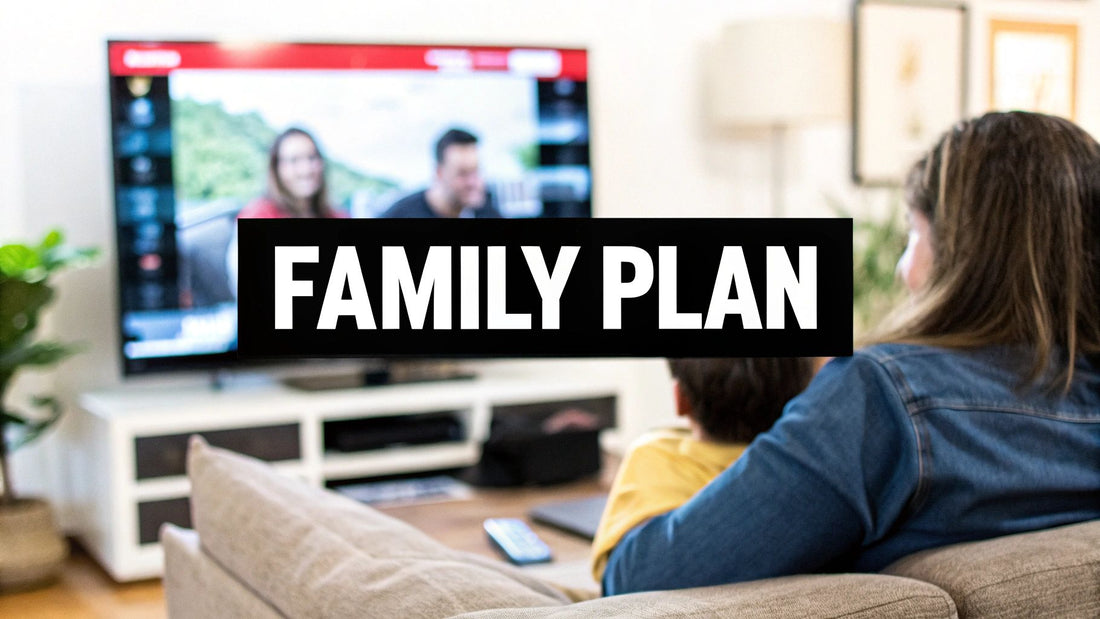
Your Guide to the YouTube TV Family Plan
Share
If you've been looking for a way to cut the cord without giving up live TV, the YouTube TV Family Plan is probably on your radar. It's designed as a single subscription that you can share with up to five other people, making it a pretty cost-effective way to get over 100 channels for the whole household.
At its core, this plan gives every member their own personalized profile and—this is the best part—their own unlimited cloud DVR. That means your viewing habits, recommendations, and recordings stay completely separate from everyone else's.
Unlocking Shared Entertainment With a Single Subscription
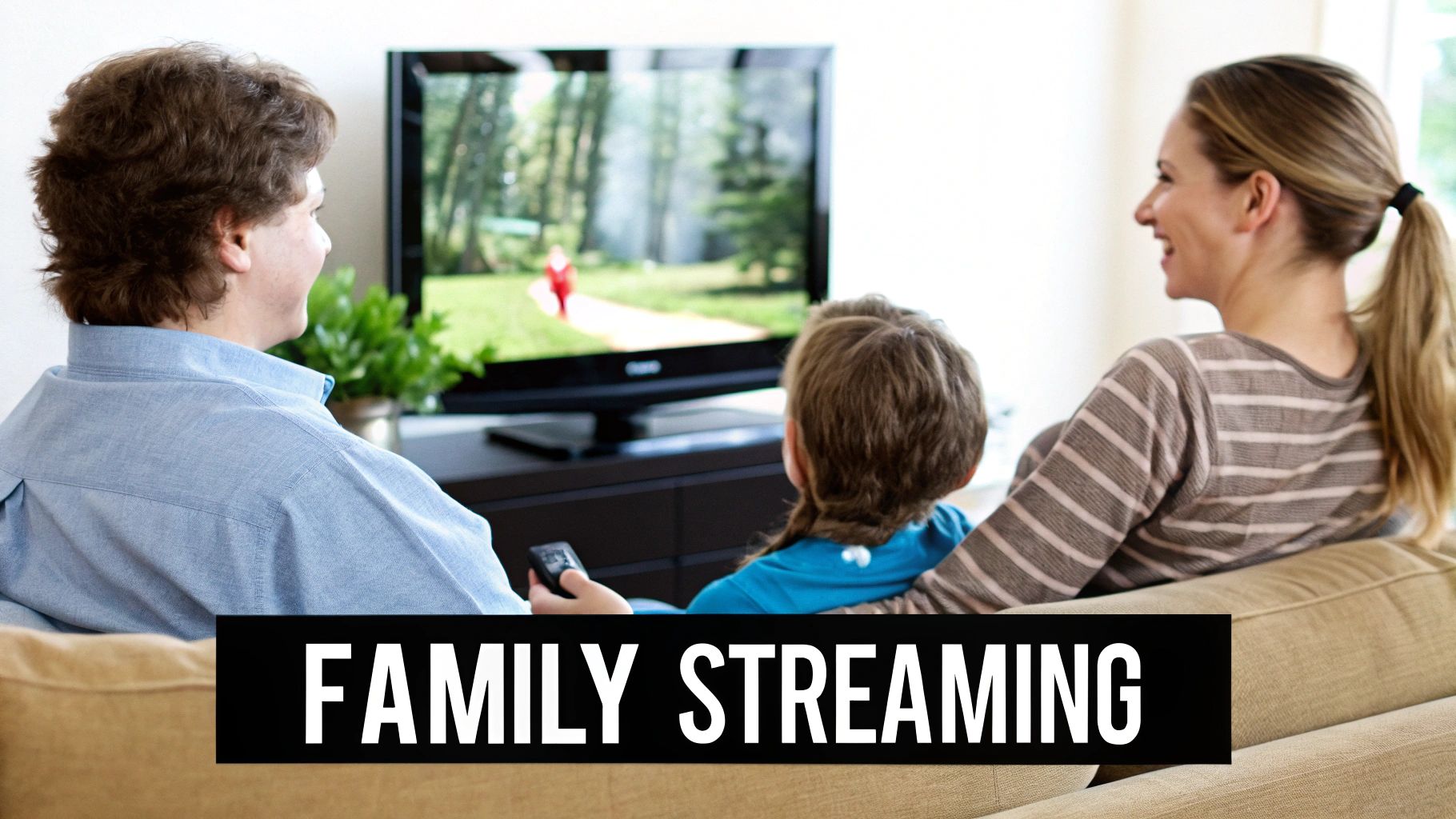
Think of the YouTube TV Family Plan as one master key for your entire household's entertainment. Instead of everyone needing their own expensive key, one person (the family manager) holds the subscription, and up to five others get their own private access. It’s a simple concept that delivers a ton of value by blending individual perks with a shared cost.
The setup is straightforward. The base plan runs $72.99 per month and unlocks that library of 100+ live channels. With that one payment, you can bring five other people into your family group, and up to three of you can be watching different things on different screens at the same time.
To give you a clearer picture, here’s a quick breakdown of what you get.
YouTube TV Family Plan Features at a Glance
| Feature | Details |
|---|---|
| Total Members | Up to 6 (1 family manager + 5 members) |
| Simultaneous Streams | 3 devices at the same time |
| Personal DVR Storage | Unlimited cloud DVR for each member |
| Individual Profiles | Each member gets their own library, recommendations, and settings |
| Cost | $72.99 per month for the base plan (for the whole group) |
| Location Requirement | All members must live in the same household |
This table shows just how much is packed into a single subscription, making it a strong contender for families or roommates.
Key Features of the Family Plan
So, what really makes this plan a great deal? It’s not just about splitting the bill; it's about giving everyone their own space within a shared account.
- Individual Profiles: Each of the six members gets their own login. No more getting recommendations for shows you’d never watch. Your watch history is yours alone.
- Unlimited Personal DVR: This is a game-changer. Every user gets their own unlimited cloud DVR. Your recorded football games won't be mixed in with someone else's reality TV marathons.
- Three Simultaneous Streams: Up to three people can stream live TV at the exact same time. This is perfect for busy households where everyone wants to watch something different.
The real magic of the YouTube TV Family Plan is its balance. It offers the financial efficiency of a shared account without sacrificing the personal customization that makes streaming enjoyable for everyone.
The Household Rule Explained
Now for the fine print. One of the most important rules to know is the "same household" requirement. YouTube TV is pretty strict that all members of a family group must live at the same physical address. They even check locations periodically to make sure everyone is playing by the rules.
This policy is in place to keep the sharing contained within a single home. It's a key distinction from other services that might be more flexible. If you’re juggling multiple subscriptions with different rules, our guide on YouTube Premium sharing options might be helpful, as those plans operate a bit differently.
Setting Up Your YouTube TV Family Group
Getting your YouTube TV family plan off the ground is surprisingly simple, and it all revolves around one key person: the family manager. Think of this person as the captain of your streaming ship. They hold the keys to the subscription and are in charge of inviting everyone else—the crew—on board. The whole process is designed to be quick so everyone can get to their own personalized profiles right away.
The journey starts in the family manager's Google account settings, which acts as the command center for all sharing permissions. From there, you just need to create a new family group and start sending out invitations. This first step is the most important one, as it lays the groundwork for the entire shared plan.
This visual breaks down the simple three-step flow from signing up to streaming.
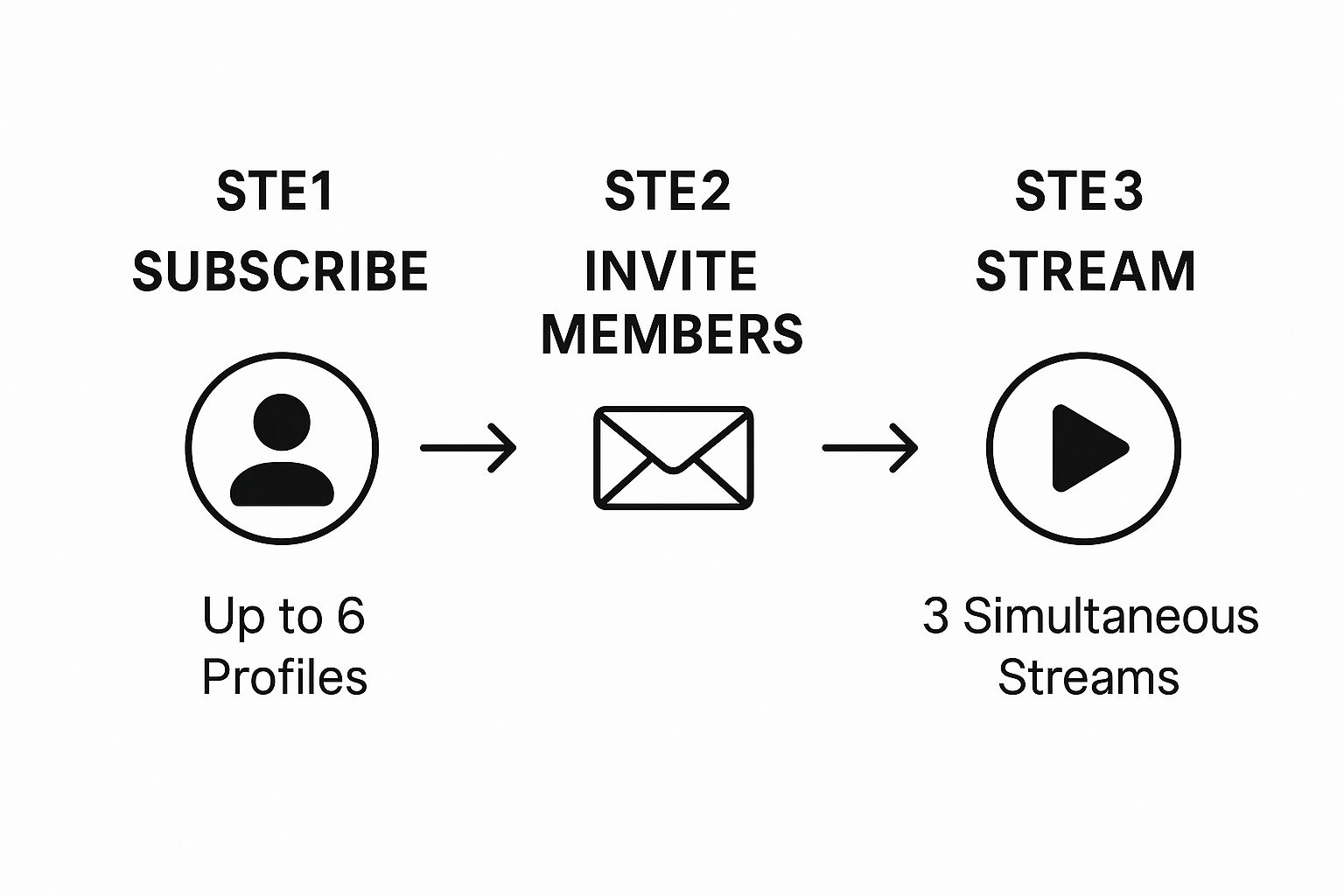
As you can see, the setup is beautifully straightforward. One subscription opens the door for up to six individual profiles, and once everyone's invited, you can have three people streaming at the same time.
Your Step-by-Step Invitation Guide
With the family group created, the manager can start adding members. Don't worry, this isn't some complex technical task; it's as easy as sending an email.
Here’s the breakdown for the family manager:
- Head to Settings: Open up YouTube TV, click your profile picture, and choose "Settings."
- Locate Family Sharing: In the menu, click on "Family Sharing," then hit "Set up."
- Invite Your Crew: You'll be prompted to add members by typing in their email addresses. You can invite up to five other people.
Each person you invite will get an email with a special link. It clearly says they've been invited to join your YouTube TV family group. All they have to do is click "Accept Invitation" and follow the quick instructions to confirm their account.
The most important thing for a family manager to remember is that you are in complete control. Adding or removing members happens exclusively through your account, giving you total oversight.
What Family Members Need to Do
If you're on the receiving end of an invitation, your job is even easier.
Once you click the acceptance link, you'll be asked to confirm that you live in the same household as the family manager. This is a crucial step that helps YouTube TV enforce its location requirements, so it's not one to skip.
After you've confirmed, your new, personalized profile is good to go. You can immediately start building your own watch history, getting tailored recommendations, and filling up your personal, unlimited DVR with your favorite shows.
For more on navigating the social side of sharing, our smart guide to sharing streaming services without the drama has some great tips for keeping things running smoothly. This simple onboarding process ensures every member gets a truly customized experience right from the start.
Understanding the Household Location Rule
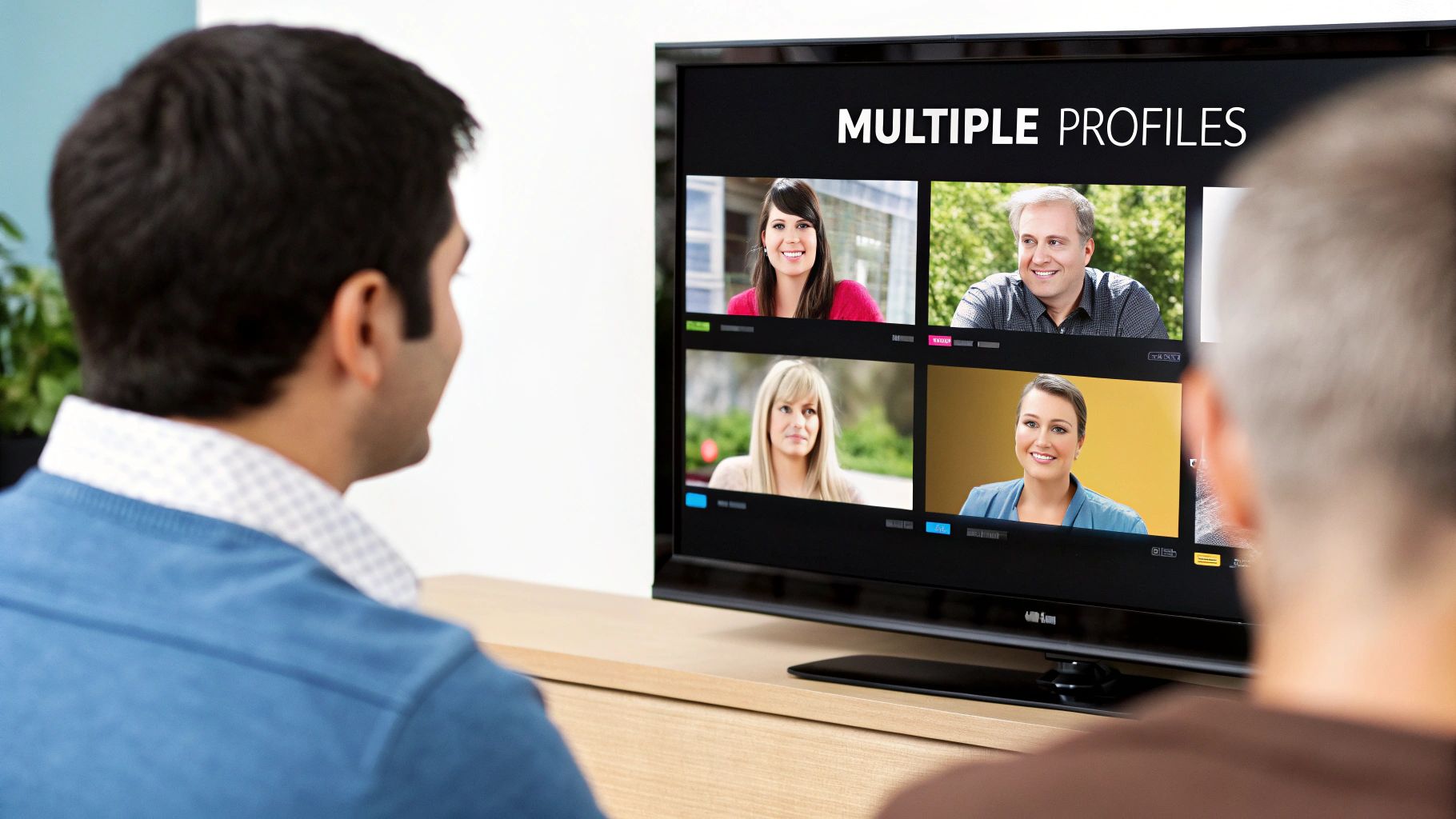
When you're setting up a YouTube TV family plan, there's one rule that stands above all others: the household location requirement. This isn't just a friendly suggestion buried in the terms of service; it's a hard-and-fast policy. Everyone in your six-person group has to live under the same roof.
This rule is Google's way of making sure a "family" plan is used by an actual family in one home, not a loose collection of friends spread across the country.
Think of it like a digital headcount. YouTube TV uses your home Wi-Fi and device GPS to periodically check that everyone is logging in from the same primary address. It’s their way of making sure all members are still part of the same household.
While you can definitely stream while on vacation, the system is smart enough to spot long-term patterns. If someone is consistently logging in from another town, they'll eventually get flagged.
How Location Verification Works
The whole verification process is pretty hands-off for you. YouTube TV isn't going to ask for utility bills, but it does run regular electronic "check-ins" to confirm everyone's location.
- Initial Setup: When the family manager first signs up, they set the "home area." This locks in your location and determines which local broadcast channels (like ABC, NBC, and CBS) you receive.
- Periodic Check-ins: At least once every 30 days, each family member needs to open the YouTube TV app from inside the designated home area. This simple action confirms they still live there.
- Mobile Use: You're free to use YouTube TV while traveling anywhere in the U.S. However, the system gives you a grace period of about three months to stream from outside your home area. After that, you'll need to check in from home again to keep your access.
This isn't just a YouTube TV thing, either. In 2023, Google started getting much stricter with its family plans across the board. The YouTube Premium Family Plan, for instance, now sees more active enforcement of its cohabitation rule. As outlets like Android Police have reported, the days of sharing these plans with distant relatives are numbered.
The bottom line is this: the YouTube TV family plan is designed for a single household. If you try to share it with people who live somewhere else, it’s not a matter of if they’ll lose access, but when.
Common Scenarios and Consequences
So, what does this look like in the real world?
A classic example is the college student. If your kid is away at a dorm for nine months of the year, they'll be considered a separate household. After that three-month travel window closes, their access will be cut off until they come home for a break and log in again. The same goes for a relative who moves out but forgets to get their own subscription.
When someone fails a location check, their account is simply blocked from streaming. The family manager gets a heads-up, but it's up to that individual member to log back in from the primary home address to restore their access. It's a straightforward system that keeps the YouTube TV family plan working as intended.
How Profiles, Streams, and DVR Libraries Work
When you share an account, the big worry is always the same: will my personal preferences get lost in the shuffle? Will I have to scroll past someone else’s reality TV binges just to find my shows? With the YouTube TV family plan, the answer is a firm "no." The whole system is designed to give everyone their own private corner of the streaming universe.
Each of the up to six family members gets their own profile. It’s best to think of these as separate apartments in the same building. Your viewing history, your recommendations, and what you save are all kept neatly within your own space. So, no, your meticulously curated feed won't suddenly be flooded with cartoons just because your nephew is visiting.
Everyone Gets Their Own Unlimited DVR
This personal-space philosophy extends to the DVR, and this is where YouTube TV really shines. Every single person in the group gets their own unlimited cloud DVR library. This is a huge deal, as it completely eliminates the classic family squabble over recording space.
Your recorded football games won't be competing for space with your partner's cooking shows. Everyone has infinite room to save whatever they want, whenever they want, without affecting anyone else's library. It’s a genuinely personalized approach that keeps the peace.
Juggling the Three-Stream Limit
While profiles and DVRs are separate, the number of simultaneous streams is shared across the whole group. The YouTube TV family plan lets up to three people watch on different devices at the same time. For most households, that's perfectly fine, but you need to be aware of the limit during prime time.
Picture a busy weeknight. Someone is watching a live game in the living room, another person is streaming a new movie in their bedroom, and a third is catching up on a series on their tablet. That's it—the three streams are all in use.
If a fourth person tries to start watching something, they'll get an error message telling them the stream limit is maxed out. They’ll have to wait for one of the other three to stop streaming before they can jump in.
This shared limit means a little coordination can go a long way, especially for bigger families. Planning ahead is the best way to avoid stepping on anyone's toes during a must-watch event.
Here are a few simple tips for making the three-stream limit work for everyone:
- Talk it out: If there's a big game or a season finale you absolutely can't miss, just give everyone a heads-up. A quick text can help you "reserve" a stream.
- Lean on the DVR: This is the easiest trick in the book. Remind everyone that if they don't have to watch something live, they can just record it and watch it later. Viewing a recorded show doesn't count against the three-stream limit.
- Download for on-the-go viewing: If someone's heading out, they can download their recorded shows to their phone or tablet. This lets them watch offline and keeps a valuable stream free for everyone back at home.
Calculating Your Savings with a Family Plan
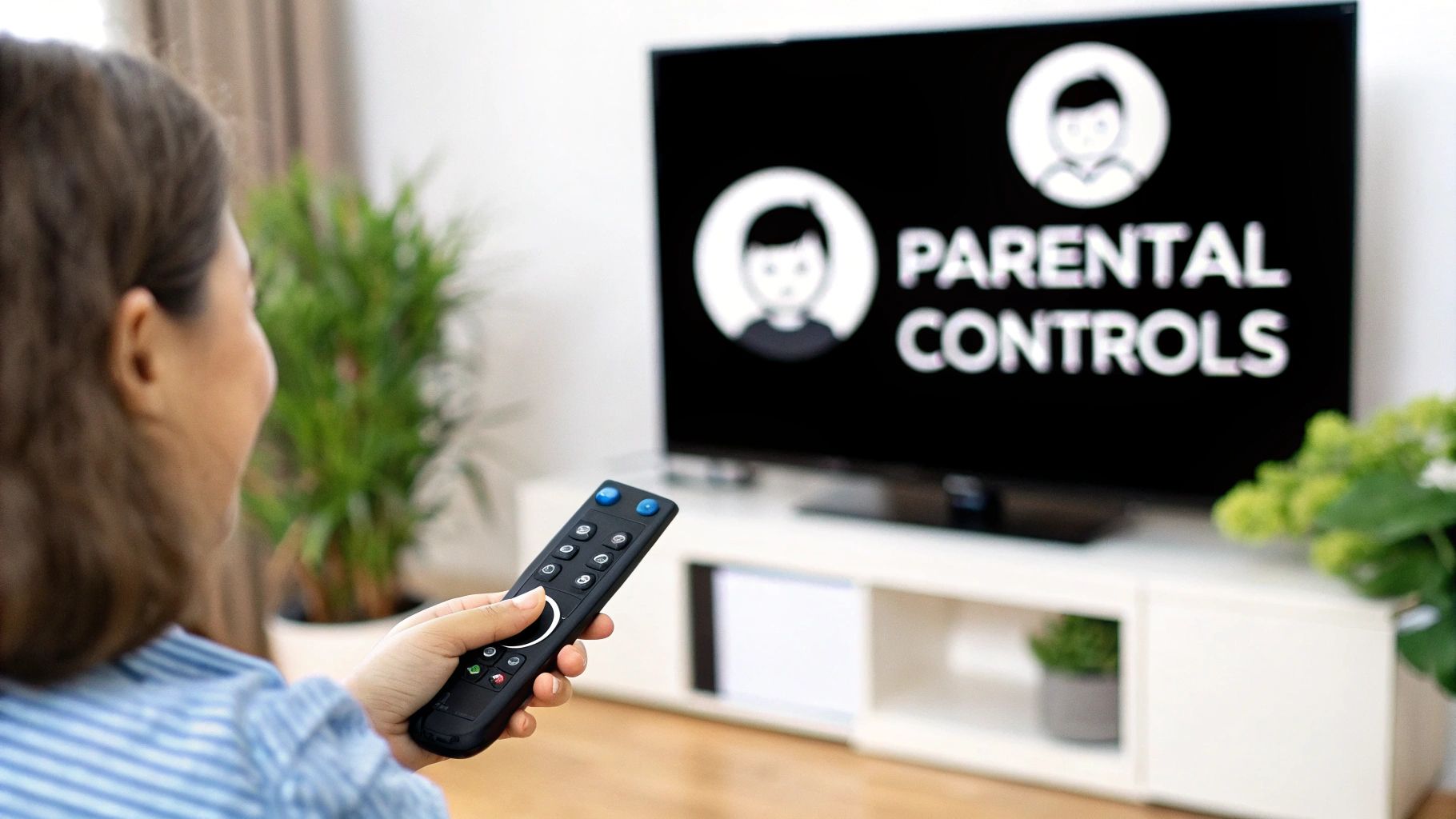
The best features of the YouTube TV family plan, like personal DVRs and custom profiles, are fantastic. But let's be honest—for most of us, it all comes down to the money. This is where the family plan really shines.
Think about it: instead of several people in your household each paying for their own subscription, one person foots a single bill that covers everyone. It’s a simple, incredibly effective way to slash your monthly entertainment costs. The more people you add to your group, the more everyone saves.
A Head-to-Head Cost Comparison
Let’s run the actual numbers. A standard YouTube TV subscription runs $72.99 a month. If just two people in your house decide to get their own separate plans, you're looking at a combined bill of nearly $146.
Switch to a family plan, and that cost plummets right back down to $72.99 for both of you. You're instantly saving half. It’s this kind of accessible pricing that has helped services like YouTube grow its paid subscriber base to over 125 million people for its Music and Premium offerings. Smart sharing models make premium features affordable for a slice of its massive 2.7 billion global users.
To really see the savings stack up, check out this simple cost breakdown.
Cost Savings with the YouTube TV Family Plan
This table shows just how much you can save each month by bundling everyone into one family plan instead of paying for individual subscriptions.
| Number of Users | Cost with Individual Plans | Cost with Family Plan | Monthly Savings |
|---|---|---|---|
| 2 | $145.98 | $72.99 | $72.99 |
| 3 | $218.97 | $72.99 | $145.98 |
| 4 | $291.96 | $72.99 | $218.97 |
| 6 | $437.94 | $72.99 | $364.95 |
As you can see, the numbers speak for themselves. With a full house of six people, you’re looking at over $360 in savings every single month.
The economic argument is undeniable. Consolidating into a single YouTube TV family plan transforms an individual expense into a shared, manageable household utility, saving hundreds or even thousands of dollars per year.
This resource-pooling strategy isn’t unique to TV streaming, either. The same logic applies to tons of other digital services. Learning how to properly manage https://accountshare.ai/blogs/new/shared-subscriptions can unlock major savings across the board, turning what could be a financial headache into a smart, collaborative win.
Your Top Questions About the Family Plan Answered
Even when you think you’ve got the YouTube TV family plan figured out, a few nagging questions always seem to surface. We’ve been there. So, we've rounded up the most common head-scratchers and pain points people run into and laid out some direct, no-nonsense answers.
Think of this as your practical guide to navigating the trickier parts of sharing your subscription, from stream limits to that infamous household rule. Getting these details right from the start is the key to a smooth, argument-free streaming life for everyone.
Can Family Members Live in a Different House?
This is, without a doubt, the number one question everyone asks. The answer is a hard no. YouTube TV’s terms of service are crystal clear: all members of a family group must live in the same household. This isn't just a friendly suggestion—it's a rule they actively enforce.
How do they know? The service periodically checks everyone’s location using a mix of IP addresses and device GPS. It also requires occasional check-ins from the designated "home area" you set up initially.
If someone is constantly logging in from a different city—say, a college kid in a dorm or a relative who moved out—their account will eventually get flagged. When that happens, they’ll lose access to the shared plan until they can log back in from the primary home location.
What Happens If a Fourth Person Tries to Stream?
The family plan draws a firm line at three simultaneous streams. This means only three people from your group can be watching anything—live TV or on-demand—at the exact same time.
So, what happens when that fourth person tries to jump in while the other three streams are running? They'll get an error message telling them the stream limit has been hit and they can't watch right now. Simple as that.
To start watching, they have to wait for one of the other three users to stop. This can definitely become a bottleneck for larger families, especially during primetime TV hours or a big game like the Super Bowl.
Does Each Person Get Their Own DVR Space?
Yes, and this is where the YouTube TV family plan really shines. Every single member of the group—all six of you—gets their own personal and unlimited cloud DVR library.
This feature is a game-changer for keeping the peace in a shared account. Your recorded shows, viewing history, and "what to watch next" recommendations stay completely separate from everyone else’s.
Think of it like this: you're all sharing a house, but everyone gets their own private bedroom. You can record as many shows, movies, and games as you want without ever messing with another family member's library or using up their space.
This means your wall-to-wall sports recordings won't get tangled up with someone else’s reality TV binges. It keeps the experience truly personal for each user.
How Do You Add or Remove a Family Member?
Managing who’s in the group is a job reserved for the family manager—the person whose Google account is used to pay for the subscription.
Here’s a quick rundown of how it works:
- To Add Someone: The family manager goes into the "Family Sharing" section in the YouTube TV settings. From there, they can shoot an email invitation to the new person. All that person has to do is accept the invite, and they're in.
- To Remove Someone: It's just as straightforward. The manager heads back to the "Family Sharing" settings, finds the person they want to remove, and confirms the action. Their access is cut off immediately.
This setup keeps things simple and secure. The person paying the bill has all the control, which prevents any confusion or unauthorized people from joining the youtube tv family plan.
Managing shared subscriptions can be a real headache, but it doesn't have to be. With AccountShare, you can securely pool your subscriptions for everything from streaming to productivity tools, making sure everyone pays their fair share without the drama. Check out how you can simplify sharing and start saving today.
